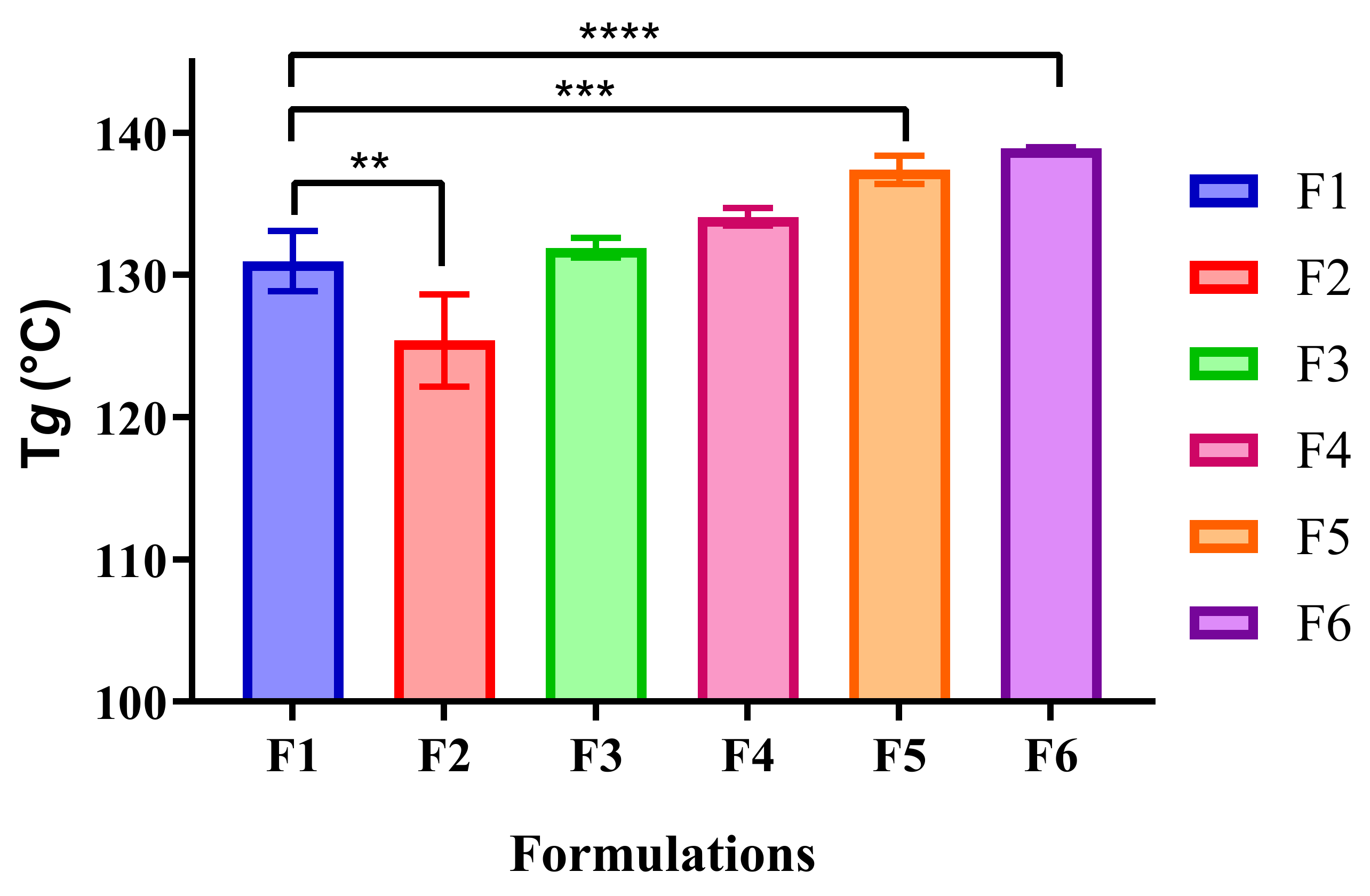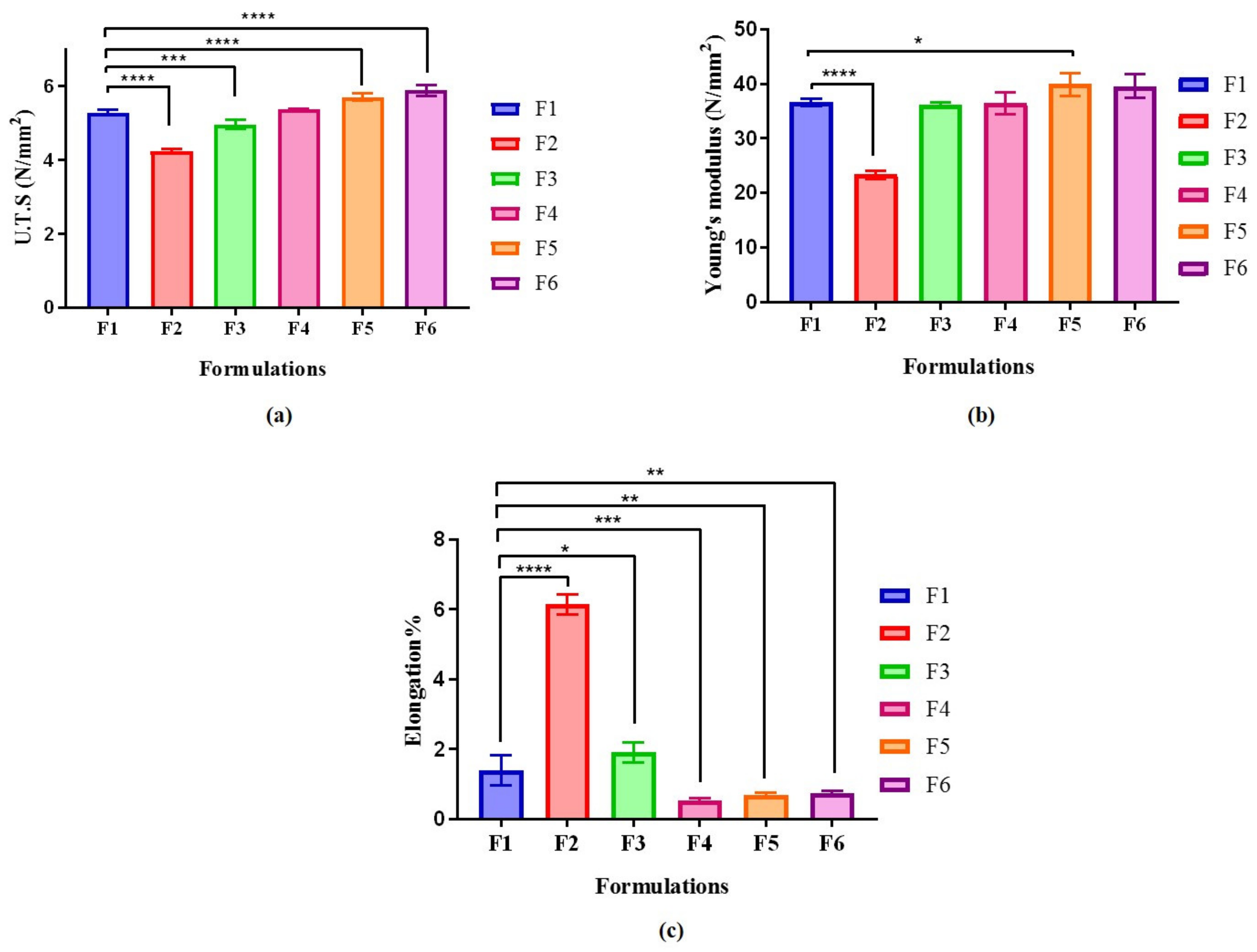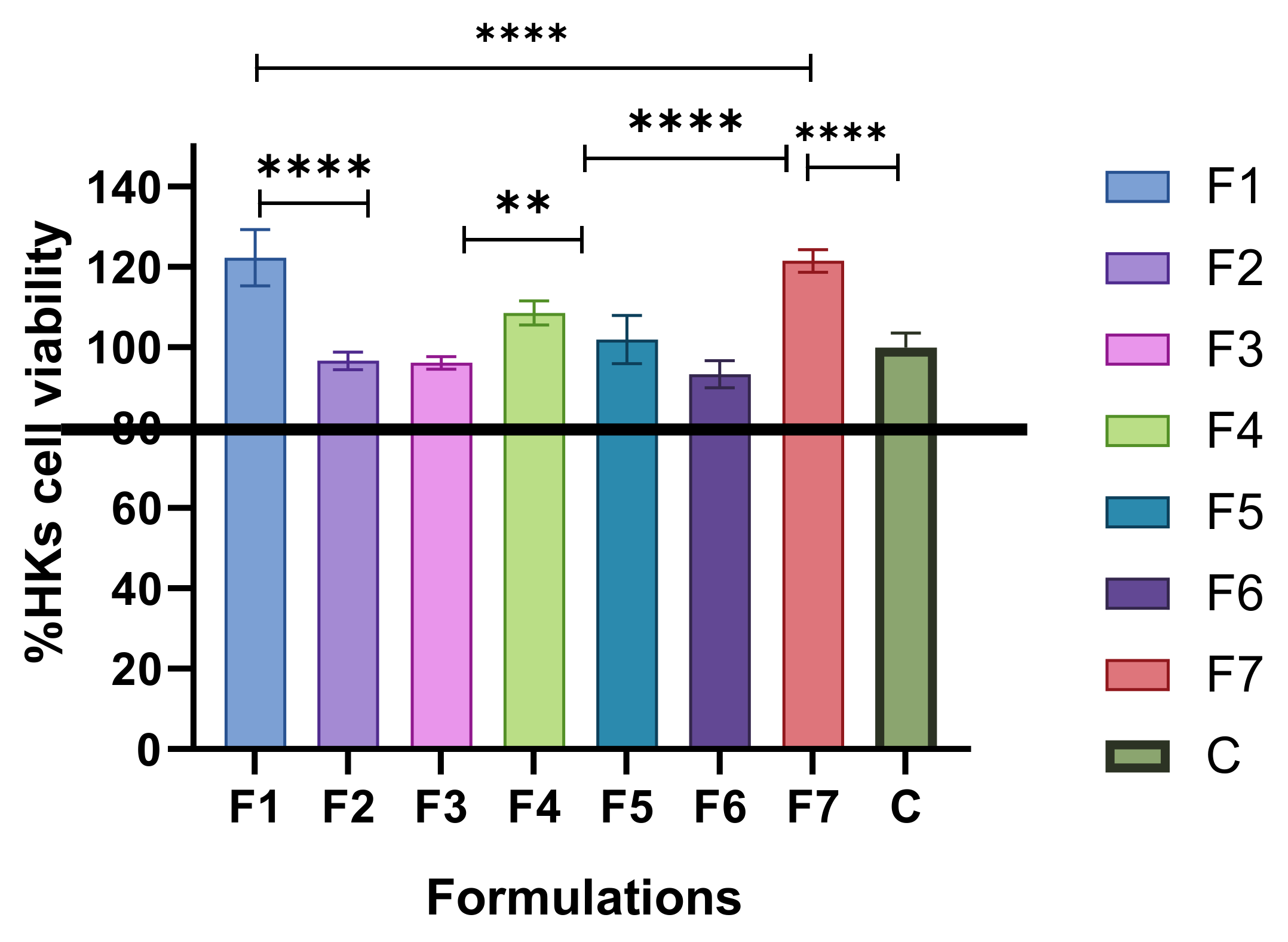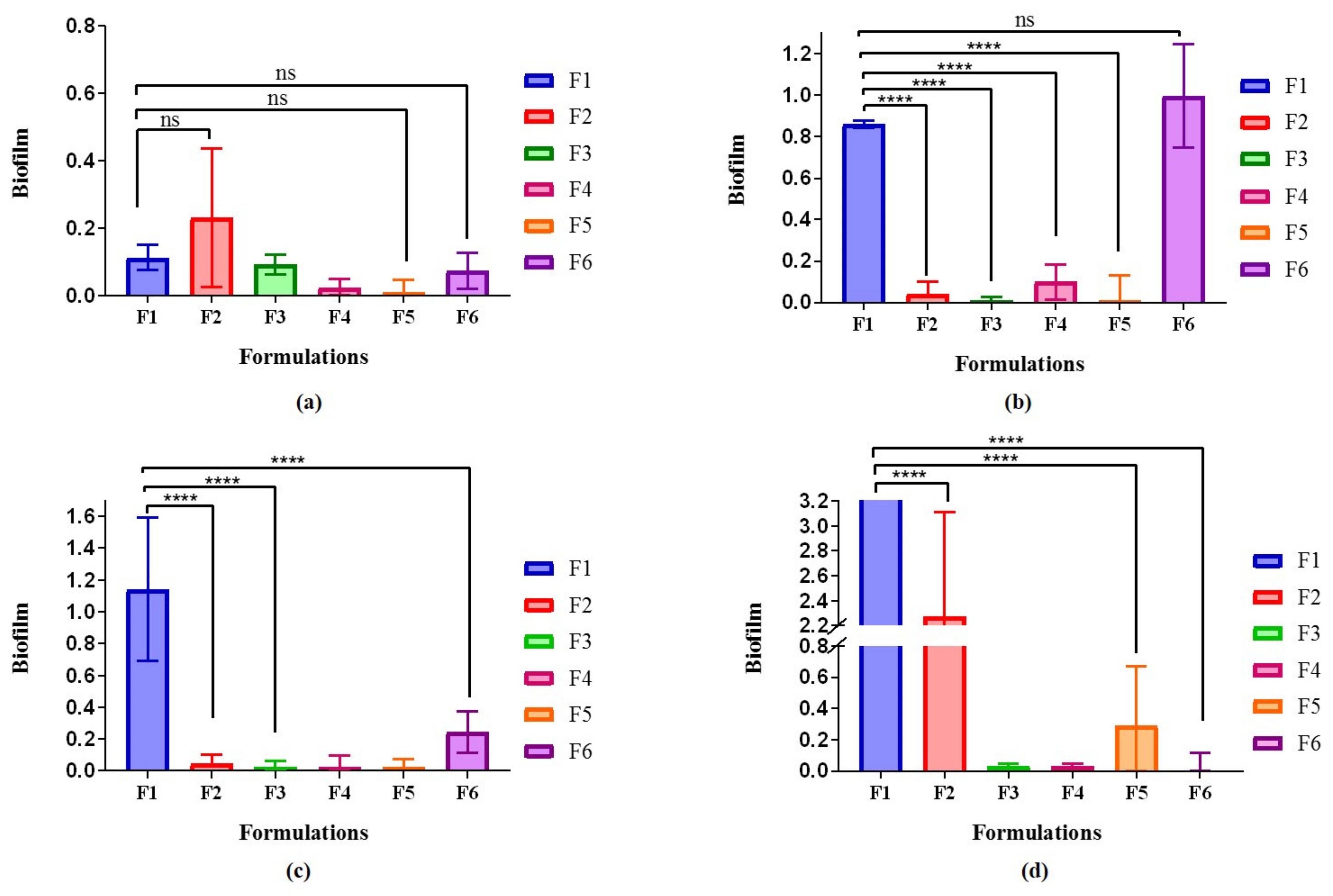Determination of Antimicrobial and Antibiofilm Activity of Combined LVX and AMP Impregnated in p(HEMA) Hydrogel
Abstract
:1. Introduction
2. Materials and Methods
2.1. Materials
2.2. Preparation of p(HEMA) Hydrogel Films
2.3. Determination of Glass Transition Temperature
2.4. Mechanical Properties
2.5. Cytotoxity Evaluation of p(HEMA) Hydrogel Formulations
2.6. Antimicrobial Activity (Zone of Inhibition)
2.7. Biofilm-Formation Ability
3. Results
3.1. Determination of Glass Transition Temperature
3.2. Mechanical Properties
3.3. Cytotoxity Evaluation of p(HEMA) Hydrogel Formulations
3.4. Antimicrobial Activity (Zone of Inhibition)
3.5. Biofilm-Formation Ability
4. Discussion
5. Conclusions
Author Contributions
Funding
Institutional Review Board Statement
Informed Consent Statement
Data Availability Statement
Acknowledgments
Conflicts of Interest
References
- Dehghanrad, F.; Nobakht-e-Ghalati, Z.; Zand, F.; Gholamzadeh, S.; Ghorbani, M.; Rosentha, V. Effect of instruction and implementation of a preventive urinary tract infection bundle on the incidence of catheter associated urinary tract infection in intensive care unit patients. Electron. J. Gen. Med. 2019, 16, em131. [Google Scholar] [CrossRef]
- Shuman, E.K.; Chenoweth, C.E. Urinary Catheter-Associated Infections. Infect. Dis. Clin. 2018, 32, 885–897. [Google Scholar] [CrossRef] [PubMed]
- Berne, C.; Ellison, C.K.; Ducret, A.; Brun, Y.V. Bacterial adhesion at the single-cell level. Nat. Rev. Microbiol. 2018, 16, 616–627. [Google Scholar] [CrossRef] [PubMed]
- Ahmadabadi, H.Y.; Yua, K.; Kizhakkedathu, J.N. Surface modification approaches for prevention of implant associated infections. Colloids Surf. B Biointerfaces 2020, 193, 111116. [Google Scholar] [CrossRef]
- Katoon, Z.; McTiernan, C.D.; Suuronen, E.J.; Mah, T.F.; Alarcon, E.I. Bacterial biofilm formation on implantable devices and approaches to its treatment and prevention. Heliyon 2018, 4, e01067. [Google Scholar] [CrossRef] [Green Version]
- Li, Y.; Li, X.; Hao, Y.; Liu, Y.; Dong, Z.; Li, K. Biological and Physiochemical Methods of Biofilm Adhesion Resistance Control of Medical-Context Surface. Int. J. Biol. Sci. 2021, 17, 1769–1781. [Google Scholar] [CrossRef]
- Zhu, Z.; Wang, Z.; Li, S.; Yuan, X. Antimicrobial strategies for urinary catheters. J. Biomed. Mater. Res. A 2018, 107, 445–467. [Google Scholar] [CrossRef]
- Wu, H.; Moser, C.; Wang, H.Z.; Høiby, N.; Song, Z.J. Strategies for combating bacterial biofilm infections. Int. J. Oral Sci. 2015, 7, 1–7. [Google Scholar] [CrossRef] [Green Version]
- Shah, K.J.; Cherabuddi, K.; Shultz, J.; Borgert, S.; Ramphal, R.; Klinker, K.P. Ampicillin for the treatment of complicated urinary tract infections caused by vancomycin-resistant Enterococcus spp (VRE): A single-center university hospital experience. Int. J. Antimicrob. Agents 2018, 51, 57–61. [Google Scholar] [CrossRef]
- Wang, S.S.; Ratliff, P.D.; Judd, W.R. Retrospective review of ceftriaxone versus levofloxacin for treatment of E. coli urinary tract infections. Int. J. Clin. Pharm. 2018, 40, 143–149. [Google Scholar] [CrossRef]
- Azargun, R.; Sadeghi, M.R.; Barhaghi, M.H.S.; Kafil, H.S.; Yeganeh, F.; Oskouee, M.A.; Ghotaslou, R. The prevalence of plasmid-mediated quinolone resistance and ESBL-production in Enterobacteriaceae isolated from urinary tract infections. Infect. Drug Resist. 2018, 11, 1007–1014. [Google Scholar] [CrossRef] [Green Version]
- Al-Soufi, W.F.; Al-Rekabi, F.M.K. Evaluating some biochemical parameters after repeated orally administration of levofloxacin in male rats. Res. J. Biotechnol. 2018, 12, 51–60. [Google Scholar]
- Hu, L.; Zhang, Q.; Li, X.; Serpe, M.J. Stimuli-responsive polymers for sensing and actuation. Mater. Horiz. 2019, 6, 1774–1793. [Google Scholar] [CrossRef]
- Hu, L.; Wan, Y.; Zhang, Q.; Serpe, M.J. Harnessing the Power of Stimuli-Responsive Polymers for Actuation. Adv. Funct. Mater. 2020, 30. [Google Scholar] [CrossRef]
- Anirudhan, T.S.; Mohan, A.M. Novel pH sensitive dual drug loaded-gelatin methacrylate/methacrylic acid hydrogel for the controlled release of antibiotics. Int. J. Biol. Macromol. 2018, 110, 167–178. [Google Scholar] [CrossRef]
- Noferini, D.; Faraone, A.; Rossi, M.; Mamontov, E.; Fratini, E.; Baglion, P. Disentangling Polymer Network and Hydration Water Dynamics in Polyhydroxyethyl Methacrylate Physical and Chemical Hydrogel. J. Phys. Chem. C 2019, 123, 19183–19194. [Google Scholar] [CrossRef]
- Pereira, A.T.; Henriques, P.C.; Costae, P.C.; Martins, M.C.L.; Magalhãesd, F.D.; Gonçalves, I.C. Graphene oxide-reinforced poly(2-hydroxyethyl methacrylate) hydrogels with extreme stiffness and high-strength. Compos. Sci. Technol. 2019, 184, 107819. [Google Scholar] [CrossRef]
- Altındal, D.Ç.; Türkyılmaz, P.; Gümüşderelioğlu, M. P(HEMA)-based SPH vehicles for high molecular weight protein delivery. Int. J. Polym. Mater. 2020, 69, 773–785. [Google Scholar] [CrossRef]
- Achilias, D.S.; Siafaka, P.I. Polymerization Kinetics of Poly (2 Hydroxyethyl Methacrylate) Hydrogels and Nanocomposite Materials. Processes 2017, 5, 21. [Google Scholar] [CrossRef] [Green Version]
- Rossos, A.K.; Banti, C.N.; Kalampounias, A.G.; Papachristodoulou, C.; Kordatos, K.; Zoumpoulakis, P.; Mavromoustakos, T.; Kourkoumelis, N.; Hadjikakou, S.K. pHEMA@AGMNA-1: A novel material for the development of antibacterial contact lens. Mater. Sci. Eng. C 2020, 111, 110770. [Google Scholar] [CrossRef] [PubMed]
- Arica, T.A.; Guzelgulgen, M.; Yildiz, A.A.; Demir, M.M. Electrospun GelMA fibers and p(HEMA) matrix composite for corneal tissue engineering. Mater. Sci. Eng. C 2021, 120, 111720. [Google Scholar] [CrossRef]
- McCoy, C.P.; Irwin, N.J.; Donnelly, L.; Jones, D.S.; Hardy, J.G.; Carson, L. Anti-Adherent Biomaterials for Prevention of Catheter Biofouling. Int. J. Pharm. 2018, 535, 420–427. [Google Scholar] [CrossRef] [PubMed] [Green Version]
- Ghanbaria, A.; Tabarsa, T.; Ashori, A.; Mashkour, M. Preparation and characterization of thermoplastic starch and cellulose nanofibers as green nanocomposites: Extrusion processing. Int. J. Biol. Macromol. 2018, 112, 442–447. [Google Scholar] [CrossRef] [PubMed]
- Tarawneh, O.; Al-Assi, A.; Hamed, R.; Sunoqrot, S.; Hasan, L.; Al-Sheikh, I.; Naser, W. Development and characterization of k-carrageenan platforms as periodontal intra-pocket films. Trop. J. Pharm. Res. 2019, 18, 1791–1798. [Google Scholar] [CrossRef]
- Liu, K.; Ostadhassan, M.; Bubach, B.; Dietrich, R.; Rasouli, V. Nano-dynamic mechanical analysis (nano-DMA) of creep behavior of shales: Bakken case study. J. Mater. Sci. 2018, 53, 4417–4432. [Google Scholar] [CrossRef]
- Namini, A.S.; Asl, M.S.; Delbari, S.A. Influence of Sintering Temperature on Microstructure and Mechanical Properties of Ti-Mo-B4C Composites. Met. Mater. Int. 2021, 27, 1092–1102. [Google Scholar] [CrossRef]
- Bhat, A.; Smith, B.; Dinu, C.Z.; Guiseppi-Elie, A. Molecular engineering of poly(HEMA-co-PEGMA)-based hydrogels: Role of minor AEMA and DMAEMA inclusion. Mater. Sci. Eng. C. 2019, 98, 89–100. [Google Scholar] [CrossRef]
- Grela, E.; Kozlowska, J.; Grabowiecka, A. Current methodology of MTT assay in bacteria–A review. Acta Histochem. 2018, 120, 303–311. [Google Scholar] [CrossRef] [PubMed]
- Mourad, R.; Helaly, F.; Darwesh, O.; EL-Sawy, S. Antimicrobial and Physicomechanical Natures of Silver Nanoparticles Incorporated into Silicone-Hydrogel Films. Contact Lens Anterio 2019, 42, 325–333. [Google Scholar] [CrossRef] [PubMed]
- Tan, Y.; Leonhard, M.; Schneider-stickler, B. Evaluation of Culture Conditions for Mixed Bio Fi Lm Formation with Clinically Isolated Non- Albicans Candida Species and Staphylococcus Epidermidis on Silicone. Microb. Pathog. 2017, 112, 215–220. [Google Scholar] [CrossRef] [PubMed]
- Kong, L.; Rosli, F.N.; Chia, H.L.; Guan, J.; Pumera, M. Self-Propelled Autonomous Mg/Pt Janus Micromotor Interaction with Human Cells. Bull. Chem. Soc. Jpn. 2019, 92, 1754–1758. [Google Scholar] [CrossRef]
- Horák, D.; Hlidková, H.; Klyuchivska, O.; Grytsyna, I. Applied Surface Science PEGylation Controls Attachment and Engulfment of Monodisperse Magnetic Poly ( 2-Hydroxyethyl Methacrylate ) Microspheres by Murine J774. 2 Macrophages. Appl. Surf. Sci. 2017, 426, 315–324. [Google Scholar] [CrossRef]
- Werida, R.H.; El-Okaby, A.M.; El-Khodary, N.M. Evaluation of levofloxacin utilization in intensive care units of tertiary care hospital: A retrospective observational study. Drugs Ther. Perspect. 2020, 36, 33–39. [Google Scholar] [CrossRef]
- Samadi, R.; Ghalavand, Z.; Nikmanesh, B.; Farahani, N.N.; Yasini, M.; Benvidi, M.E.; Eslami, G. Investigation of Biofilm Formation Among Methicillin-Resistant Staphylococcus Aureus Isolated from Children. Arch. Pediatr. Infect. Dis. 2018, 6. [Google Scholar] [CrossRef] [Green Version]
- Qiao, C.; Ma, X.; Zhang, J.; Yao, J. Effect of hydration on water state, glass transition dynamics and crystalline structure in chitosan films. Carbohydr. Polym. 2019, 206, 602–608. [Google Scholar] [CrossRef]
- Zhang, K.; Hanb, L.; Nie, Y.; Szigeti, M.L.; Ishida, H. Examining the effect of hydroxyl groups on the thermal properties of polybenzoxazines: Using molecular design and Monte Carlo simulation. RSC Adv. 2018, 8, 18038–18050. [Google Scholar] [CrossRef] [Green Version]
- SheinbaumL, M.; Sheinbaum, L.; Weizman, O.; Dodiuk, H.; Kenig, S. Toughening and enhancing mechanical and thermal properties of adhesives and glass-fiber-reinforced epoxy composites by brominated epoxy. Compos. B Eng. 2019, 15, 604–612. [Google Scholar] [CrossRef]
- Ma, X.; Zheng, F.; Lu, Q. Role of Intrinsic Factors of Polyimides in Glass Transition Temperature: An Atomistic Investigation. J. Phys. Chem. B 2019, 123, 8569–8579. [Google Scholar] [CrossRef]
- Emter, R.; Natsch, A. A Fast Resazurin-Based Live Viability Assay Is Equivalent to the MTT-Test in the KeratinoSens Assay. Toxicol. Vitr. 2015, 29, 688–693. [Google Scholar] [CrossRef] [PubMed]
- Laskowski, D.; Strzelecki, J.; Pawlak, K.; Dahm, H.; Balter, A. Effect of ampicillin on adhesive properties of bacteria examined by atomic force microscopy. Micron 2018, 112, 84–90. [Google Scholar] [CrossRef]
- El-Baky, R.M.A.; Sandle, T.; John, J.; Abuo-Rhma, G.E.A.A.; Hetta, H.F. A novel mechanism of action of ketoconazole: Inhibition of the NorA efflux pump system and biofilm formation in multidrug-resistant Staphylococcus aureus. Infect. Drug Resist. 2019, 12, 1703–1718. [Google Scholar] [CrossRef] [PubMed] [Green Version]





| Formulation | Antimicrobial Agent (g) | 2-HEMA (g) |
|---|---|---|
| F1 (control) | _______ | 9.8 |
| F2 | 0.05 AMP | 9.75 |
| F3 | 0.05 LVX | 9.75 |
| F4 | AMP: LVX (1:1) 0.025:0.025 | 9.75 |
| F5 | AMP: LVX (3:1) 0.0375:0.0125 | 9.75 |
| F6 | AMP: LVX (1:3) 0.0125: 0.0375 | 9.75 |
Publisher’s Note: MDPI stays neutral with regard to jurisdictional claims in published maps and institutional affiliations. |
© 2021 by the authors. Licensee MDPI, Basel, Switzerland. This article is an open access article distributed under the terms and conditions of the Creative Commons Attribution (CC BY) license (https://creativecommons.org/licenses/by/4.0/).
Share and Cite
Tarawneh, O.; Alwahsh, W.; Abul-Futouh, H.; Al-Samad, L.A.; Hamadneh, L.; Abu Mahfouz, H.; Fadhil Abed, A. Determination of Antimicrobial and Antibiofilm Activity of Combined LVX and AMP Impregnated in p(HEMA) Hydrogel. Appl. Sci. 2021, 11, 8345. https://doi.org/10.3390/app11188345
Tarawneh O, Alwahsh W, Abul-Futouh H, Al-Samad LA, Hamadneh L, Abu Mahfouz H, Fadhil Abed A. Determination of Antimicrobial and Antibiofilm Activity of Combined LVX and AMP Impregnated in p(HEMA) Hydrogel. Applied Sciences. 2021; 11(18):8345. https://doi.org/10.3390/app11188345
Chicago/Turabian StyleTarawneh, Ola, Wasan Alwahsh, Hassan Abul-Futouh, Luma A. Al-Samad, Lama Hamadneh, Hadeel Abu Mahfouz, and Abdulqader Fadhil Abed. 2021. "Determination of Antimicrobial and Antibiofilm Activity of Combined LVX and AMP Impregnated in p(HEMA) Hydrogel" Applied Sciences 11, no. 18: 8345. https://doi.org/10.3390/app11188345







